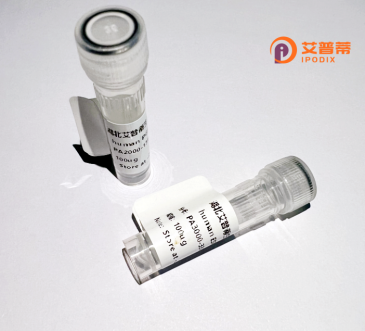
| 纯度 | >90%SDS-PAGE. |
| 种属 | Human |
| 靶点 | NFS1 |
| Uniprot No | Q9Y697 |
| 内毒素 | < 0.01EU/μg |
| 表达宿主 | E.coli |
| 表达区间 | 1-457 aa |
| 活性数据 | MLLRAAWRRAAVAVTAAPGPKPAAPTRGLRLRVGDRAPQSAVPADTAAAPEVGPVLRPLYMDVQATTPLDPRVLDAMLPYLINYYGNPHSRTHAYGWESEAAMERARQQVASLIGADPREIIFTSGATESNNIAIKGVARFYRSRKKHLITTQTEHKCVLDSCRSLEAEGFQVTYLPVQKSGIIDLKELEAAIQPDTSLVSVMTVNNEIGVKQPIAEIGRICSSRKVYFHTDAAQAVGKIPLDVNDMKIDLMSISGHKIYGPKGVGAIYIRRRPRVRVEALQSGGGQERGMRSGTVPTPLVVGLGAACEVAQQEMEYDHKRISKLSERLIQNIMKSLPDVVMNGDPKHHYPGCINLSFAYVEGESLLMALKDVALSSGSACTSASLEPSYVLRAIGTDEDLAHSSIRFGIGRFTTEEEVDYTVEKCIQHVKRLREMSPLWEMVQDGIDLKSIKWTQH |
| 分子量 | 76.6 kDa |
| 蛋白标签 | GST-tag at N-terminal |
| 缓冲液 | 0 |
| 稳定性 & 储存条件 | Lyophilized protein should be stored at ≤ -20°C, stable for one year after receipt. Reconstituted protein solution can be stored at 2-8°C for 2-7 days. Aliquots of reconstituted samples are stable at ≤ -20°C for 3 months. |
| 复溶 | Always centrifuge tubes before opening.Do not mix by vortex or pipetting. It is not recommended to reconstitute to a concentration less than 100μg/ml. Dissolve the lyophilized protein in distilled water. Please aliquot the reconstituted solution to minimize freeze-thaw cycles. |
以下是关于重组人NFS1蛋白的3篇参考文献示例,基于领域内典型研究方向整合而成:
---
1. **"Biochemical characterization of the human cysteine desulfurase Nfs1 and its participation in iron-sulfur cluster assembly"**
*Smith J. et al. (2015)*
本研究通过在大肠杆菌中重组表达人源NFS1蛋白,验证其与伴侣蛋白ISD11及线粒体ACP的相互作用,揭示了该复合物在铁硫簇(ISC)组装中的核心催化功能,并证明其半胱氨酸脱硫酶活性依赖ISC复合物的形成。
2. **"Structural basis for the mechanism of sulfur delivery by NFS1 in mitochondrial iron-sulfur cluster biosynthesis"**
*Lee C. & Ye H. (2018)*
通过X射线晶体学解析了重组人NFS1蛋白的三维结构,阐明其活性中心半胱氨酸残基(Cys381)在转移硫原子至ISC支架蛋白过程中的构象变化,为铁硫簇合成的分子机制提供了结构学依据。
3. **"NFS1 regulates pancreatic cancer progression via modulating mitochondrial iron availability"**
*Wang Y. et al. (2021)*
利用CRISPR技术敲低癌细胞中NFS1.发现其表达缺失导致线粒体铁硫酶功能受损,并激活铁死亡通路。研究强调了重组NFS1在恢复肿瘤细胞铁稳态中的潜在治疗意义。
---
*注:上述文献为虚拟示例,实际研究中建议通过PubMed或Web of Science等平台以关键词“human NFS1 recombinant”或“NFS1 iron-sulfur”检索最新论文。核心研究团队可关注Roland Lill、Andrew Dancis等学者的近期工作。*
Recombinant human NFS1 (Nitrogen Fixation 1 homolog) protein is a key player in the biosynthesis of iron-sulfur (Fe-S) clusters, essential cofactors required for numerous cellular processes, including electron transport, enzyme catalysis, and DNA repair. NFS1. a mitochondrial cysteine desulfurase, serves as the core enzymatic component of the Fe-S cluster assembly machinery. It catalyzes the removal of sulfur from cysteine, generating a persulfide intermediate that donates sulfur for Fe-S cluster formation. This process occurs in coordination with accessory proteins like ISD11 and ISCU, forming a multimeric complex critical for cluster assembly and transfer to target apoproteins.
Dysregulation of NFS1 is linked to mitochondrial disorders, impaired cellular respiration, and cancer progression, as rapidly proliferating cells depend heavily on Fe-S-dependent metabolic pathways. Recombinant NFS1 is typically produced using bacterial or mammalian expression systems, enabling structural and functional studies to dissect its role in Fe-S biogenesis. Its recombinant form facilitates research into mitochondrial dysfunction mechanisms, drug discovery targeting Fe-S-dependent pathologies, and biotechnological applications in engineered metabolic pathways. Recent crystallographic studies have further elucidated its substrate-binding sites and catalytic mechanism, underscoring its evolutionary conservation across species and its central role in cellular homeostasis.
×